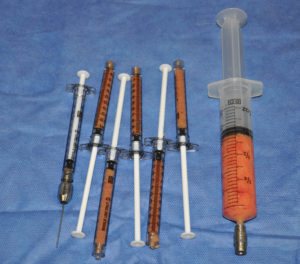The use of one’s own fat for the correction of a variety of aesthetic and reconstructive soft tissue needs in plastic surgery is now more than just a fad. It has rapidly become an established technique even though much of the science as to how it works, and sometimes does not work, is far from established. While it is now widely used, there are still a relatively small number of clinical articles that document the outcomes of its use.

In the May 2013 issue of the Annals of Plastic Surgery, an article appeared in print entitled ‘ Autologous Fat Transfer for Aesthetic Facial Contouring’. In this paper the authors report on their experience with fat transfer for facial grooves and facial volume correction. This was a retrospective review of seventy-five (750 autologous fat transfers over a three year period performed in 8 female patients between the ages of 45 to 75 years old. The injections were performed to improve facial aesthetic contours of which 22 were for correction of grooves and creases, nasolabial folds (12), glabellar furrows (4), and nasojugal folds. (6) Fifty-three (53) transfers were performed for volume augmentation, malar (17), submalar (14), lip (11), temple (8), chin (2), and jowl. (1) The injected fat was harvested using a tumescent technique with manual syringes from the abdomen. The fat was prepared by decanting, discarding oil and nonviable fat layers.Care was taken to reduce the time from harvest to transplantation with no syringe transfers. The mean volume of fat transferred was 24 mL (range of 4 to 54 mls). The mean follow-up was 25 months, ranging from 6 to 36 months. A second session of fat transfer was required in some patients. Complications included minor asymmetry in 1 patient (resolved with graft manipulation) and prolonged swelling in another. No postoperative cellulitis or fat necrosis was reported. A patient satisfaction rating was 88% and all patients reported (100%) that they would have the procedure performed again.
This is a fat grafting clinical study that has a lot of flaws, a low number of patients, no method to measure actual volume retention and a satisfaction assessment based on surgeon and patient perceptions. (which, of course, is the most important measure) But this study is also a likely sample of how fat grafting is now widely performed in the U.S. and its facial uses, fat graft volumes needed, and postoperative results would be considered typical.
What this study demonstrates is that facial fat grafting is very safe, has no significant costs and has very few complications. Other than the potential need for repeat grafting or inadequate volume retention or symmetries, there is little downside to its use. Injected fat may not always survive but it causes no problems and is almost always available from any patient. For these reasons, fat grafting in the aging face has become a useful rejuvenative method to consider. How to make it an even more predictable facial volume enhancement method will become apparent over the next few years as more and more patients receive it and plastic surgeons learn and refine their techniques.
Dr. Barry Eppley
Indianapolis, Indiana


